#crab nebula
Explore tagged Tumblr posts
Text

Crab Nebula from Visible to X-Ray ©
#space#nasa#chandra observatory#hubble telescope#stars#astrophotography#solar system#crab nebula#galaxy#planet#universe#astronomy#cosmos#night sky
1K notes
·
View notes
Text
Pride Flags Colorpicked from Nebulas











#nebulas#space#nasa#trifid nebula#crab nebula#lagoon nebula#astronomy#aroace#aro#ace#aromantic#arospec#aromantic spectrum#transgender#bisexual#asexual#bi#trans#color picked flags#colorpicked flags#color picked pride flags#colorpicked pride flags#colour picked flags#colourpicked flags#colour picked pride flags#colourpicked pride flags#lgbtq#lgbtqia
1K notes
·
View notes
Text



From the depths of the ocean to the most distant galaxies, we’re all connected! 💫 💙
Recently, @montereybayaquarium Executive Director Julie Packard and Space Telescope Science Institute Director Dr. Jennifer M. Lotz were honored with 2024 Clarke Foundation awards.
In celebration, the Aquarium has partnered with STScI to bring you images from outer space and Earth’s life-giving ocean. It’s in moments like these that we can pause to appreciate and be in awe of the world we live in. As John Steinbeck and Ed Ricketts wrote in “The Log from the Sea of Cortez”: “It is advisable to look from the tide pool to the stars and then back to the tide pool again.” ✨
Credit: NASA,ESA, and the Monterey Bay Aquarium.
#space#astronomy#stsci#science#nasa#universe#hubble#hubble space telescope#hubble telescope#clarke foundation#monterey bay aquarium#aquarium#oceans#earth#crab nebula#jelly fish#anemone#nudibranch#nebula#galaxies
249 notes
·
View notes
Text

From Asimov on Astronomy, 1976.
210 notes
·
View notes
Text

What powers the Crab Nebula? A city-sized magnetized neutron star spinning around 30 times a second. Known as the Crab Pulsar, it is the bright spot in the center of the nebula's core. About 10 light-years across, the spectacular picture of the Crab Nebula (M1) frames a swirling central disk and complex filaments of surrounding and expanding glowing gas. The picture combines visible light from the Hubble Space Telescope in red and blue with X-ray light from the Chandra X-ray Observatory shown in white, and X-ray emission detected by Imaging X-ray Polarimetry Explorer (IXPE) in purple. The central pulsar powers the Crab Nebula's emission and expansion by slightly slowing its spin rate, which drives out a wind of energetic electrons.
Image Copyright & Credit: NASA, ESA, ASI, Hubble, Chandra, IXPE
#astronomy#space#science#universe#crab#nebula#Crab Nebula#pulsar#neutron star#star#neutron#xray#visible light#xray light#light year#Chandra#follow#like#reblog#the first star#the first starr#thefirststar#thefirststarr#nasa#apod#tumblr#pretty#beautiful#blog#space blog
172 notes
·
View notes
Text

The Crab Nebula, M1 // Mike Mulcahy
#astronomy#astrophotography#nebula#emission nebula#supernova remnant#crab nebula#messier#messier 1#M1#NGC 1952#Taurus A#taurus
67 notes
·
View notes
Text
Y'all, I'm getting emotional.
One of my absolute favorite astronomical bodies is the Crab Nebula, or Messier 1. The Crab Nebula is a "planetary nebula", which means it's the enormous, beautiful corpse of a once-giant star. The star that formed the Crab Nebula went supernova and exploded in 1054, and was so bright at the time of its death that you could see it from Earth during the day - for almost a month. For that month, it was brighter than every single thing in the sky except the moon and the sun. Some of you have probably heard of it, or have at least seen this Hubble picture:
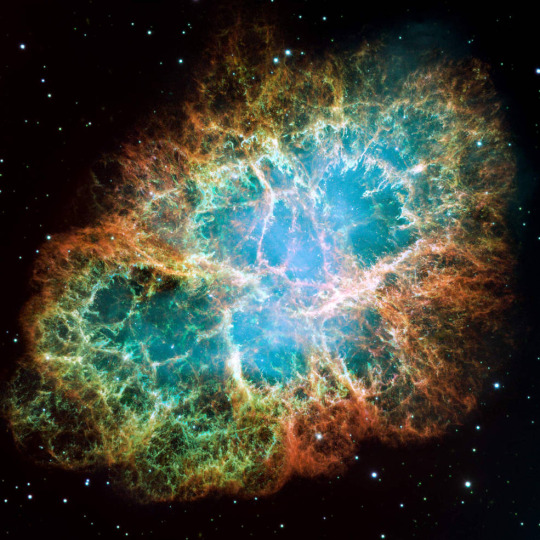
But how many of y'all have zoomed in?
Inside all of those lovely rainbow clouds is the supernova remnant - a neutron star. A neutron star is made of the densest possible material that we know of - any denser, and it'd collapse the rest of the way into a full-fledged black hole. Neutron stars are so unimaginably dense that they're not even made of an element, not really. The star at the center of the Crab Nebula is one, single atomic nucleus 12 miles in diameter, made entirely of close-packed neutrons. One teaspoon would weigh 10 million tons. Imagine taking a passenger jet, condensing it down to the size of a mote of dust, and then filling a spoon with that dust. And it spins too - 30 times a second. That spinning causes huge jets of material to eject from the poles at half the speed of light. The incredibly powerful magnetic field traps any stray particles and accelerates them in circular paths through the nebula. Just LOOK at this shit! See the ghosty shadows of the jets, stretching from the top left corner to the bottom right?
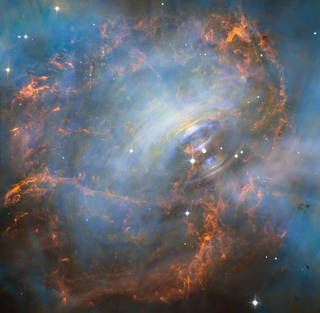
But what's really making me lose it is this Hubble timelapse. The star is making ripples. Its moving. Its been dead for almost a thousand years, but its still putting on its final, spectacular show.
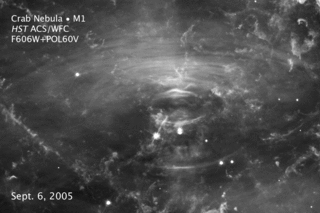
It never ceases to amaze me that the things we call "dead" stars are some of the most dynamic, energetic, and awe-inspiring objects in the universe. Normal stars are downright STAGNANT compared to what these so-called "stellar remnants" get up to. Maybe we shouldn't be thinking of them as dead stars, but as the next phase in a star's life. Just as caterpillars "end" their mundane lives and metamorphose into something new and strange and capable of flight, these stars destroy themselves to leave behind something far more exotic, playing at the edge of the laws of physics in ways we still don't fully understand.
#space#crab nebula#neutron star#supernova#god I fucking love neutron stars#ask me sometime about the first pulsar#hubble#spost#space post
747 notes
·
View notes
Text
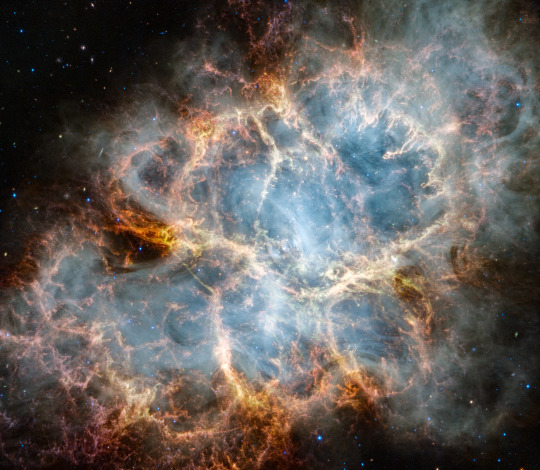
Crab Nebula as captured by the James Webb Space Telescope (30 October 2023)
#space#james webb space telescope#james webb#crab nebula#astrophotography#james webb images#nebula#nasa#cosmos#oh my gods this is so fucking beautiful#science#astronomy
443 notes
·
View notes
Text

M1: Filaments of the Crab Nebula - February 7th, 1997.
"The Crab Nebula is filled with mysterious filaments. It is the result of a star that exploded in 1054 AD. This spectacular supernova was recorded by the Chinese and, quite possibly, Anasazi Indian astronomers. The filaments are mysterious, because they appear to have less mass than expelled in the original supernova, and higher speed than expected from a free explosion. In the above picture, the colour indicates what is happening to the electrons in different parts of the Crab Nebula. Red indicates the electrons are recombining with protons to form neutral hydrogen, while green indicates the electrons are whirling around the magnetic field of the inner nebula. In the nebula's very center lies a pulsar: a neutron star rotating; in this case, 30 times a second."
28 notes
·
View notes
Text
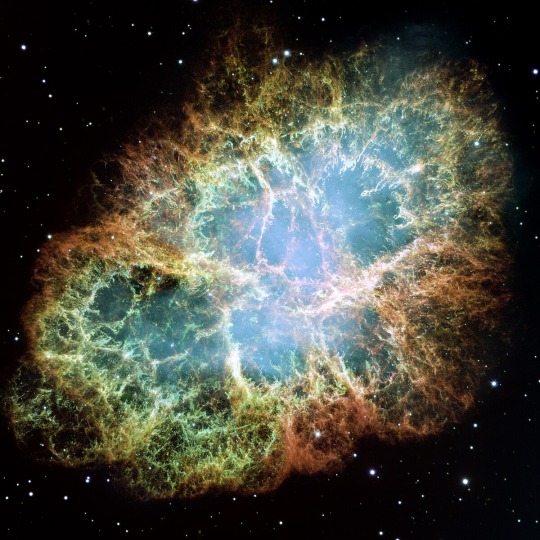
Messier 1, Also known as the Crab Nebula, a supernova remnant in the constellation of Taurus as seen by the Hubble Space Telescope. (Image Credits go to NASA/ESA)
192 notes
·
View notes
Text

Acrylic painting of Crab Nebula, which I drew for competition then I was still in school
23 notes
·
View notes
Text

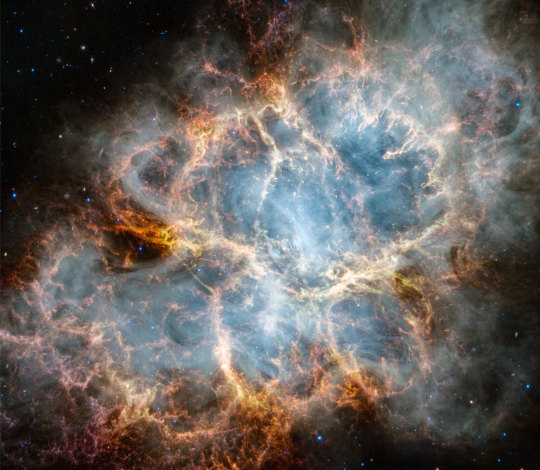
M1: The Incredible Expanding Crab ©
#nasa#apod#messeir 1#crab nebula#astrophotography#space#solar system#planet#galaxy#stars#universe#astronomy#cosmos
882 notes
·
View notes
Text
Messier-1: The Crab Nebula.
What a story: this is the remnant of a nearby star that exploded in 1054. We know the exact timing because ancient Chinese astronomers documented everything.
So, what you see here is the explosion in progress, but almost a thousand years later.
Note that the remnants of this star, when it exploded, ejected into long strands. It is not clear to me why the explosion created these strands.

I captured this composite image from my garden in Strasbourg France on a cold night in December 2024, and a frosty night in early January 2025. 65 x 180 seconds each. (3.25 hours)
#astrophotography#astronomy#astrophotographie#astronomie#astrophotographiefrance#strasbourg#crab nebula#messierobjects#messier1#astronomiefrance#supernova remnant
17 notes
·
View notes
Text

M1 the Crab Nebula. A supernova remnant and pulsar wind nebula 6,500 ly away sitting on the tip top of the left horn of Taurus the Bull. Had difficulty editing this one and not sure if I'm fully happy with it, but it'll do because I'm tired.
115 notes
·
View notes
Text

crab nebula by james webb (nircam, miri)
#crab nebula#nebula#james webb#james webb space telescope#space#space images#astronomy#miri#nircam#stem#cosmos
36 notes
·
View notes
Text
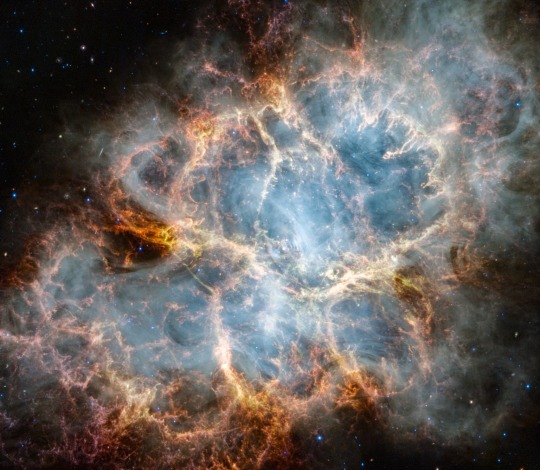
Crab Nebula, taken by the James Webb Space Telescope’s NIRCam (Near-Infrared Camera) & MIRI (Mid-Infrared Instrument)
Published by NASA 10/30/23
#photography#space#telescope#james webb space telescope#nebula#crab nebula#universe#stars#infrared#astronomy#galaxies#discovery#science#nasa
102 notes
·
View notes